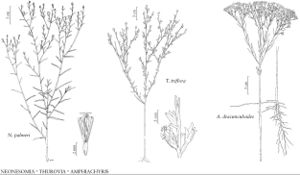Neonesomia palmeri
Sida 21: 253. 2004.
Common names: Texas desert goldenrod Texas goldenweed
Illustrated
Basionym: Aster palmeri A. Gray Proc. Amer. Acad. Arts 17: 209. 1882
Synonyms: Ericameria austrotexana M. C. Johnston Xylothamia palmeri (A. Gray) G. L. Nesom
Stems: bark tan, becoming brown to gray; twigs mostly green, prominently ridged. Leaves moderately crowded; blades spreading, 10–30 × 1–2 mm, plane; axillary fascicles rarely present. Phyllaries 1.5–5.2 × 0.8–1.2 mm, midveins enlarged near apex, resin gland and surrounding tissue evident as green to brown patches. Ray laminae 2.5–3 × 0.5–1 mm. Disc corollas 3.8–5.5 mm, tubes glabrous, lobes unequal, 1–2.7 mm; style branches 1.5–2.2 mm, appendages 0.7–1.1 mm. Cypselae 1.5–2 mm; pappi 3.7–5.3 mm. 2n = 18.
Phenology: Flowering fall.
Habitat: Associated with brushy vegetation, brushy pastures, saline flats, coastal dunes
Elevation: 0–600 m
Distribution
Loading map...

Tex., Mexico (Nuevo León, Tamaulipas).
Discussion
Neonesomia palmeri grows on open flats to steep slopes in saline to sandy habitats in southern Texas.
Selected References
None.
Lower Taxa
None.
